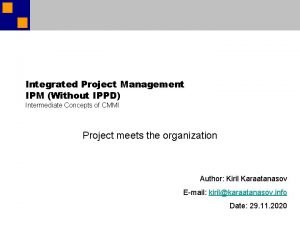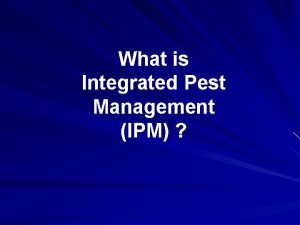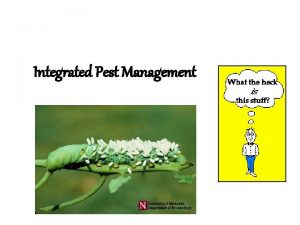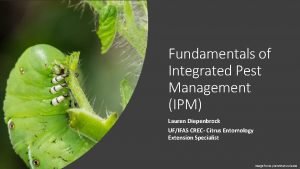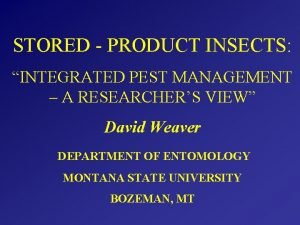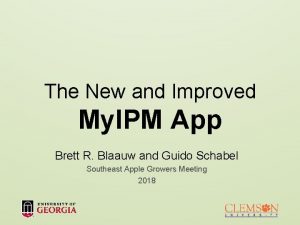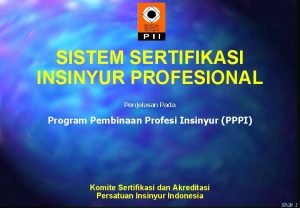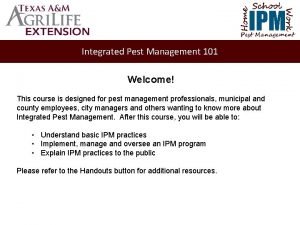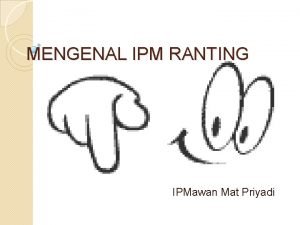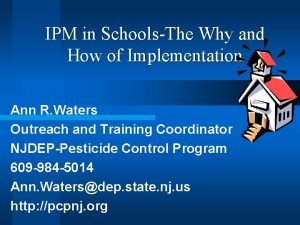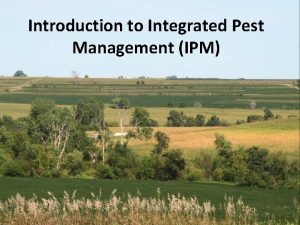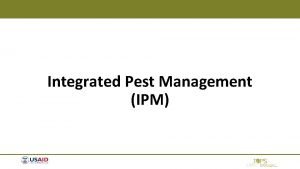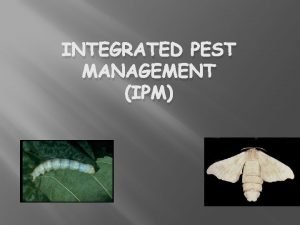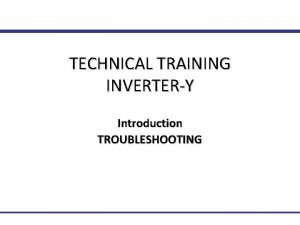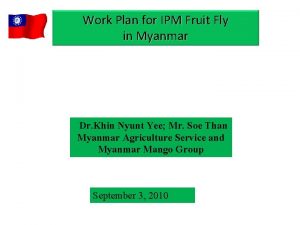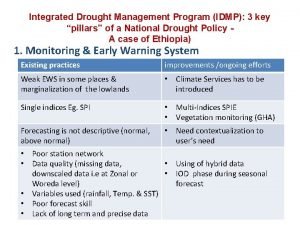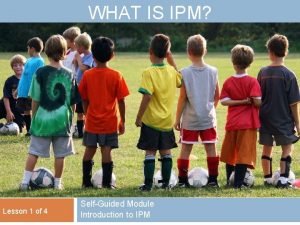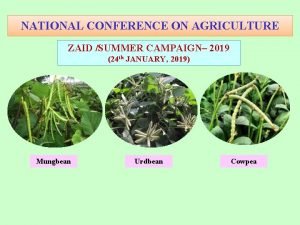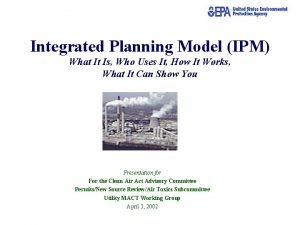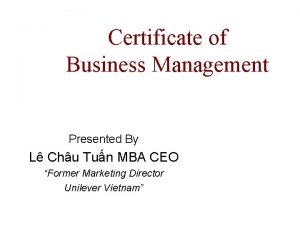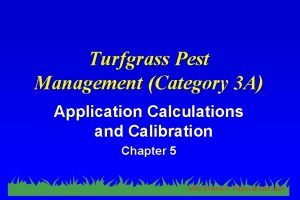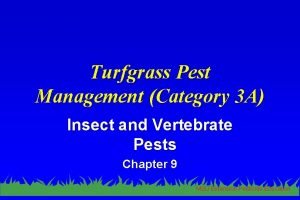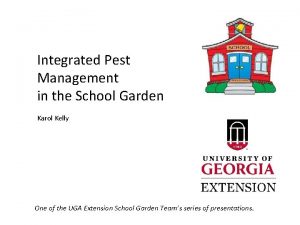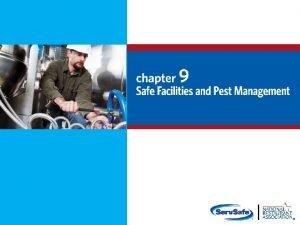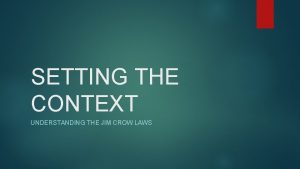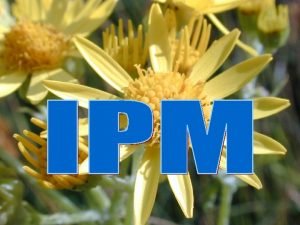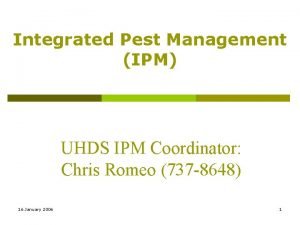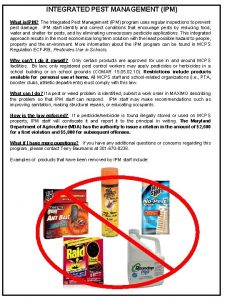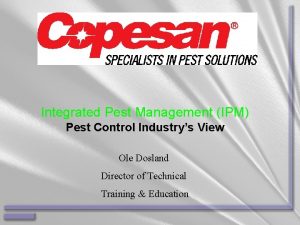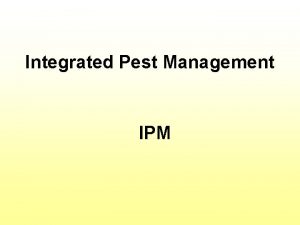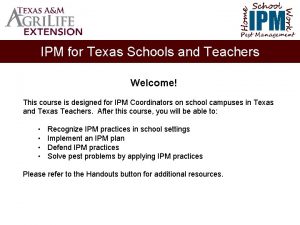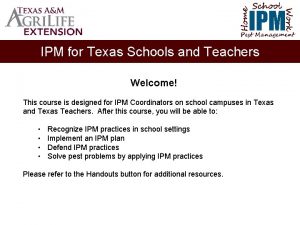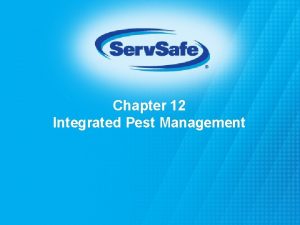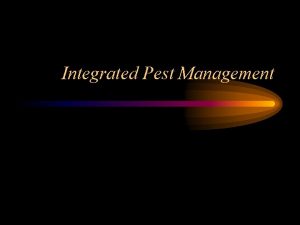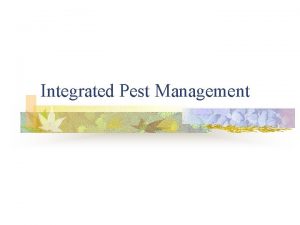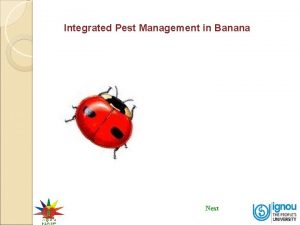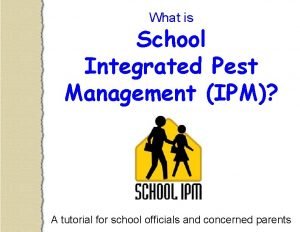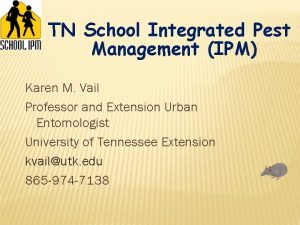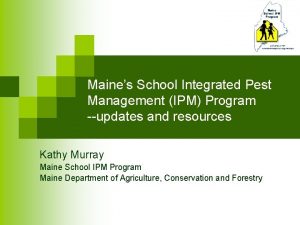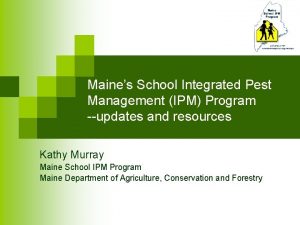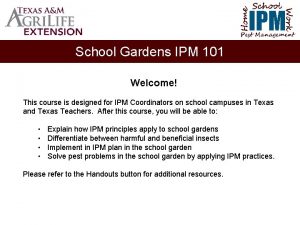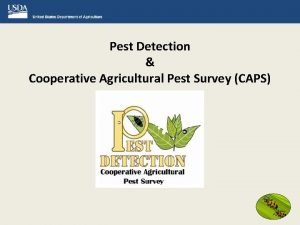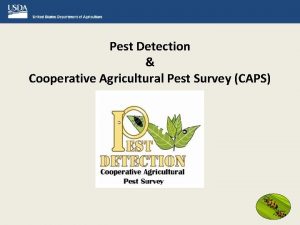Integrated Pest Management IPM in the School Setting



































- Slides: 35

Integrated Pest Management (IPM) in the School Setting: Strategies for Protecting Children from Exposure Janet Hurley, MPA and Mike Merchant, Ph. D Texas Agri. Life Extension Service School IPM Program

Integrated pest management • It’s not just pest control but a way to think and react to everyday actions. • IPM is about roaches, rats, ants, bats, birds, weeds and more. • IPM is also about maintaining the school building so it’s safe for teachers and students. • IPM is a about people working together.

History of School IPM • U. S. EPA “introduced” school IPM in early 1990 s o Grants were provided to land grant institutions to develop materials to help schools understand a different way to control pest. • Regional IPM Centers founded to promote better adoption of IPM and research better solutions to problems in 1999. o Regional IPM Centers began promoting school IPM research in the new millennium

History of School IPM • Texas & Michigan were first to Adopt School IPM Mandates – 1991 and 1992 • To date there are 39 states with some form of regulation or mandate that either requires or requests schools to follow IPM guidelines. • Federal Legislation - School Environment Protection Act (SEPA) was introduced into Congress in 1999, but it has never succeeded as states prefer local control, rather than Federal.

EPA & USDA • United in encouraging schools to adopt school IPM. • Have developed a national strategic plan to have every school practicing school IPM by 2015. • You can help this goal by understanding your role in Integrated Pest Management Program in your School.

IPM Defined • IPM is a strategy using multiple control tactics to ensure that: o pest populations are managed at acceptable levels o risks to people, other non-target organisms and the environment are minimized o the pest control program is practical and economical

How is IPM different? • • IPM focuses on safe and effective ways to control pests Delicate balance between pests & pesticides Multiple tactics proven most effective Thresholds and monitoring ensure pesticides are used only when necessary • Routine inspections & monitoring are essential – routine spraying is not.

Essential Ingredients for an IPM Program • IPM Coordinator • IPM Policy • Employee Involvement o Pest management is people management • Inspections and monitoring • Pest identification • Managed Treatments o Using action thresholds o Use of multiple control tactics • Education

IPM Coordinator • Is the designated person responsible for overseeing the day to day pest problems. • Is also responsible for maintaining the building structure so that pests can’t move into the building. • This person often wears many hats and relies on school employees to help with reporting building repairs or pest problems. • This person also ensures that advance notice of pesticide treatments is posted in the area that is to be treated. o For more information regarding this policy please contract your local coordinator for more information

IPM Policy Statement • Should detail the districts intent towards IPM and what guidelines they will follow. • Should have statements about monitoring, inspections, establishing thresholds, who can apply pesticides, how problems should be reported, and who should be educated about the program. • Should be adopted by the School Board to set a standard for the district • Additional areas for IPM to be successful o Work with the pest management professional to draft pest management plans. o Adopt an IPM (IAQ) committee to meet periodically to discuss environmental issues for the district. o Educate teachers, custodians, food service, maintenance and grounds workers about their role in IPM.

Employee Involvement • Remember IPM is everyone’s Job! • Everyone has a role to play when it comes to IPM o Report broken doors, leaky faucets, cracked windows. o Pick up clutter in your room o Don’t leave food, crumbs, candy and other items around. o Store food items in locking plastic containers o Report food and drink spillages when they occur.

Inspections • Simple o These types of inspections are often conducted by the pest control company or licensed pesticide applicator • Done on a monthly basis • Intense o Reviews the entire building integrity looking for pest entry ways or hiding places • Done annually or every other year based on age • New issue o Complaint comes in to a non-monitored area o Critical for public health pests

What is an IPM inspection? • Goes beyond sanitation • Looks for critical things pests need o food o water o temperature o harborage The pest triangle

What is an IPM inspection? • Reduce a “requisite” reduce a pest • Sanitation, not pesticides will control pests The pest triangle

Monitoring • Monitoring/sampling o Monitoring - sampling over time to observe trends and changes in pest activity o Uses a simple device (glueboard, sticky trap) o Sampling - observing and recording pest presence or numbers • Trap checking to see if control measures are working or not.

Reporting • Pest sighting logs o Notebooks placed with food service and campus secretary • Work orders o Online system to report pest complaints and building problems • Contact IPM Coordinator o Designated person of contact • Report to secretary, head custodian, others o Someone who can contact building services for notification of problem.

IPM pyramid ides c i t s e P l a c i n a h Mec s) rier r a b , s p a ntrols (tr co co t, h g li t, a e (h ls o tr n o c Physical Education/Awarenes s Pest pro ofing/San itation ld)

Common Pests in Schools • Cockroaches: o Skin fragments and feces are the most common cause of asthma in urban youth. o They are also responsible for transmitting several food born illnesses • Ants: o Fire ant stings cause several human deaths per year. o Several ant species can invade electrical equipment

Common Pests in Schools • Rodents: o Deadly hantavirus is transmitted by rodent urine and feces o Transmits several food born illnesses o Has been linked to plague thru fleas • Bees & Wasps o Stings can cause allergic reaction o Rapid development of nest in some cases overnight

Forces affecting IPM today • School/Community IPM Initiatives • LEED buildings • Certification programs • Clean Water Act • Bed bugs • Insurance – Termite warranty work

Bed Bugs What to do if you encounter this pest at your school

Bed bug IPM: A brief overview Michael Merchant, Ph. D, BCE Texas Agri. Life Research and Extension Center at Dallas

Identification • 4 -5 mm-long (size of apple seed), • mahogony-colored, wingless, flattened • Pronotal bristles toothed (microscopic)


Bedbugs • Infestations increasing nationwide • Adults approx. 3/16 inch-long • Hide in cracks and crevices during day • Previously fed adults can survive 6 -7 months without human host • Must feed on blood from humans, pets, birds or bats Photo by M. Merchant

Bed bug feeding habits • Prefer feeding during darkness • Bites painless • 50% of people with bed bug infestations may not know they are being bitten • High risk of infestation moving from one apartment to adjacent apartment

Photo by M. Merchant © Entomological Society of America

Photo by clairebelles, courtesy Flickr

Challenges with bed bugs • Hiding places diverse o 50% on or around bed o Upholstered chairs, sofas, nightstands, dressers, other furniture o Baseboards, under carpet tack strip, any small cracks, behind posters, clocks, etc. • Replacing mattress more a problem than a solution o Mattress and box spring encasements the answer Family of bed bugs around recessed screw in plastic office chair

Challenges with bed bugs • Control expensive o Labor-intensive o Success highly dependent on customer cooperation o Cleaning infested clothes • Freeze 10 -12 hours min. • Hot-setting on drier 30 min. • Hot wash 30 mins. (140 o) • Dry cleaning effective o Pesticides not highly effective

Challenges with bed bugs • Bed bugs are excellent hitchhikers o Suitcases o Clothing o Backpacks • Bed bugs are good runners Photo by Ed Yourdon, Flickr

Monitoring and detection • Look for fecal specks and bugs around beds o Headboards in hotels o Mattresses in homes • Sticky cards not very effective • CO 2 traps becoming more useful • New passive monitoring traps • Dogs

More Information • Texas Agri. Life School IPM Program o http: //schoolipm. tamu. edu o http: //Citybugs. tamu. edu • National School IPM Information Source o http: //schoolipm. ifas. ufl. edu/ • US EPA – Healthy Schools o http: //cfpub. epa. gov/schools/index. cfm • IPM Centers o http: //www. ipmcenters. org/ • IPM Institute of North America o http: //www. ipminstitute. org/

Contact Information Janet Hurley, MPA – Extension Program Specialist II Shannon Cox, MS, CHES School IPM Texas Agri. Life Extension Service Health Education Coordinator III Southwest Technical Resource Center Southwest Center for Pediatric Environmental Health 17360 Coit Road, Dallas, Texas 75252 University of Texas Health Science Center Tyler Phone: 877 -747 -6872 or 972 -952 -9213 11937 US Hwy 271, Tyler, Texas 75708 Fax: 972 -952 -9632 Phone: 888 -901 -5665 or 903 -877 -5045 Email: ja-hurley@tamu. edu Fax: 903 -877 -7982 Facebook: http: //facebook. com/School. IPMTexas Email: shannon. cox@uthct. edu Website: www. swcpeh. org Michael Merchant, Ph. D. , BCE Janie Fields, MPA Professor and Extension Urban Entomologist Executive Director Texas Agri. Life Research and Extension Center Children’s Environmental Health Institute 17360 Coit Road, Dallas, Texas 75252 3000 B. Island Way, Austin, Texas 78746 Phone: 972 -952 -9204 Phone: 512 -657 -7405 Email: m-merchant@tamu. edu Email: janie. fields@cehi. org Website: http: //citybugs. tamu. edu Website: www. cehi. org 10/18/2021 34

Contact Information Monique Mills, MD Associate Professor or Pediatrics University of Texas Health Science Center Tyler 11937 US Hwy 271, Tyler, Texas 75708 Phone: 903 -877 -5941 Email: monique. mills@uthct. edu Website: www. uthct. edu Healthy School Network Inc. 773 Madison Avenue, Albany, New York 12208 Phone: 518 -462 -0632 Fax: 518 -462 -0433 Website: www. healthyschools. org www. nationalhealthyschoolsday. org Playback Link for Webinar: https: //sas. elluminate. com/mr. jnlp? suid=M. 643 CA 475977 D 25 AEE 8 E 6 DC 7 AE 14 C 1 F&sid=2009292 Will be available for 5 business days to view 10/18/2021 35
 Cmmi ipm
Cmmi ipm Integrated pest management objectives
Integrated pest management objectives Integrated pest management
Integrated pest management Ipm
Ipm Integrated pest management ____ than pesticides.
Integrated pest management ____ than pesticides. What is the third step in integrated pest management?
What is the third step in integrated pest management? My ipm
My ipm Sertifikasi insinyur profesional
Sertifikasi insinyur profesional Basic ipm for the classroom and office environment
Basic ipm for the classroom and office environment Ipm adalah
Ipm adalah What is an ipm plan
What is an ipm plan Ipm meaning
Ipm meaning Ipm meaning
Ipm meaning Sejarah ipm
Sejarah ipm Invertery
Invertery Ipm myanmar
Ipm myanmar Pillars of ipm
Pillars of ipm Ipm grade 1
Ipm grade 1 Ipm indeks pembangunan manusia
Ipm indeks pembangunan manusia Ipm 410-3 (shikha) price
Ipm 410-3 (shikha) price Integrated planning model
Integrated planning model Ipm pipe
Ipm pipe Ipm tuyển dụng
Ipm tuyển dụng Turfgrass pest management (category 3a practice test)
Turfgrass pest management (category 3a practice test) Pest management alliance
Pest management alliance Turfgrass pest management
Turfgrass pest management Biological control
Biological control Safe facilities and pest management
Safe facilities and pest management Understanding jim crow (setting the setting)
Understanding jim crow (setting the setting) Hát kết hợp bộ gõ cơ thể
Hát kết hợp bộ gõ cơ thể Slidetodoc
Slidetodoc Bổ thể
Bổ thể Tỉ lệ cơ thể trẻ em
Tỉ lệ cơ thể trẻ em Chó sói
Chó sói Glasgow thang điểm
Glasgow thang điểm Chúa sống lại
Chúa sống lại
